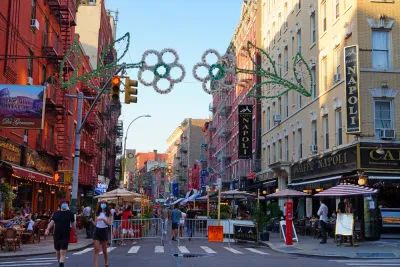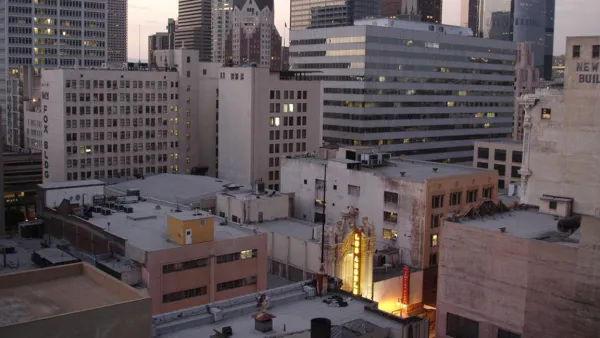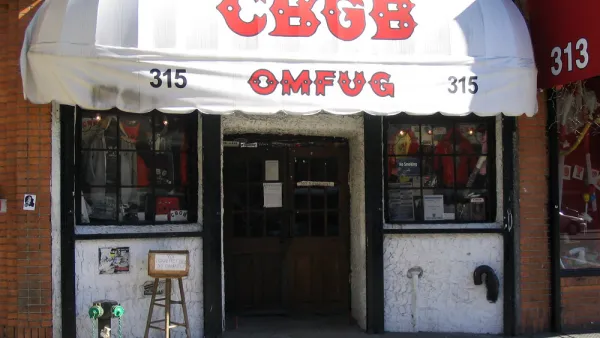Urban cores around the country were transforming into live, work, and play destinations before the pandemic. The pandemic was a setback for this transformation, but it could also be a rare opportunity. It’s up to city leadership to seize it.

“The nation is in the midst of one of the biggest workforce shifts in generations,” writes the Washington Post Editorial Board, describing the effects of nearly three years of stay-at-home orders, working from home, and hybrid work schedules. “Many now have experienced what it is like to work from home and have discovered they prefer it.”
While much of the discussion in cities has focused on the fiscal distress caused by office vacancies, the loss of demand for retail uses in urban cores, declining transit ridership, and shifting commute patterns, less frequently addressed is the opportunity to, for lack of a better phrase, build back better—to turn the crisis of downtown vacancies into an opportunity to solve some of the challenges facing downtowns and regions since even before the pandemic.
The Washington Post writes to refocus the discussion on the opportunities, identifying two obvious opportunities—to return workers to offices and to convert commercial spaces to residential units and entertainment venues.
“This is a once-in-a-generation opportunity to reshape downtowns for the future. It should be a top priority of mayors and city councils around the country,” according to the editorial. “The goal is a ‘24/7’ downtown with ample work spaces, apartments, parks and entertainment venues that draw people in during the day and have a core of residents who keep the area vibrant after commuters go home.”
While that kind of downtown environment was becoming more common in many U.S. cities before the pandemic, many cities had a long way to go in attracting the residential population required to provide a “24-7” downtown.
According to the editorial, both priorities will face substantial challenges, overcome by political will and creative thinking. On the theme of workers returning to the office, D.C. Mayor Muriel Bowser recently called on President Joe Biden to return federal workers to offices for the sake of D.C.’s downtown. New York Mayor Eric Adams has also been a vocal proponent for returning to the office. According to the editorial, workers are already returning to the office, but it’s unlikely they will ever return to pre-pandemic levels. For the foreseeable future, downtowns will be oversupplied with office uses.
So adaptive reuse will be necessary. The editorial identifies a growing interest by developers to begin conversion projects, but multiple hurdles remain. The Washington Post suggests specific actions that can make the most of the opportunity, including setting clear goals for new residents in downtown, speeding up permitting for adaptive reuse projects, creating new financing mechanisms, and thinking beyond housing. More detail on each of these suggestions are available in the source article below.
FULL STORY: Downtowns are lifeless. It’s a once-in-a-generation chance to revive them.

Analysis: Cybertruck Fatality Rate Far Exceeds That of Ford Pinto
The Tesla Cybertruck was recalled seven times last year.

National Parks Layoffs Will Cause Communities to Lose Billions
Thousands of essential park workers were laid off this week, just before the busy spring break season.

Retro-silient?: America’s First “Eco-burb,” The Woodlands Turns 50
A master-planned community north of Houston offers lessons on green infrastructure and resilient design, but falls short of its founder’s lofty affordability and walkability goals.

Test News Post 1
This is a summary

Analysis: Cybertruck Fatality Rate Far Exceeds That of Ford Pinto
The Tesla Cybertruck was recalled seven times last year.

Test News Headline 46
Test for the image on the front page.
Urban Design for Planners 1: Software Tools
This six-course series explores essential urban design concepts using open source software and equips planners with the tools they need to participate fully in the urban design process.
Planning for Universal Design
Learn the tools for implementing Universal Design in planning regulations.
EMC Planning Group, Inc.
Planetizen
Planetizen
Mpact (formerly Rail~Volution)
Great Falls Development Authority, Inc.
HUDs Office of Policy Development and Research
NYU Wagner Graduate School of Public Service




























